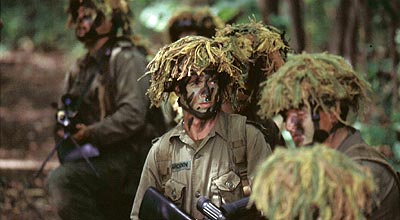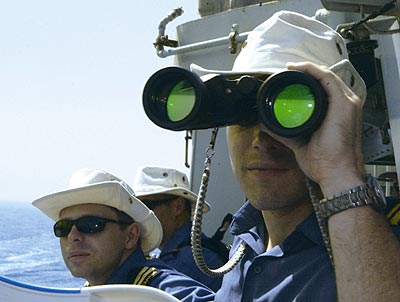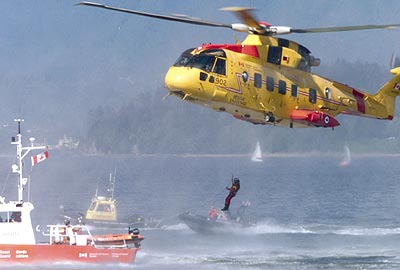 This information has been archived for reference or research purposes.
This information has been archived for reference or research purposes.
Archived Content
Information identified as archived on the Web is for reference, research or recordkeeping purposes. It has not been altered or updated after the date of archiving. Web pages that are archived on the Web are not subject to the Government of Canada Web Standards. As per the Communications Policy of the Government of Canada, you can request alternate formats on the "Contact Us" page.
Policy

Photo by Silvia Pecota
Militia soldiers.
A Grand Strategy For A Small Country
For more information on accessing this file, please visit our help page.
Editor’s Note: This is the text of an address given at the Conference of Defence Associations Institute Graduate Student Symposium at Royal Military College on 24 October 2003.
In this presentation I would like to share my perspective on the real strategic challenges Ottawa will face in terms of our diplomatic and military priorities and the likely context within which those choices will be made.
My overarching analytical bias is about the kind of Prime Minister Mr. Martin will be in the context of military and foreign policy decisions. Broadly stated, I see Prime Ministers Diefenbaker, Trudeau and Chrétien as largely disengaged from the larger geopolitical world, and unenthusiastic about any military role for Canada in that geopolitical world. They simply had no concept of how military, diplomatic and democratic capacity were jointly and severally essential to the advancement of our genuine national interests and shared values.
While they had inherent or passing interests in issues like Apartheid, or the Preferential Commonwealth Tariff, or world peace, or development in Africa, they were largely domestic Prime Ministers. Mr. Diefenbaker’s nationalism, Mr. Trudeau’s condescension towards Mr. Nixon, Mr. Chrétien’s discomfort on Iraq, were all about a mix of domestic pique and serious personality mismatches between our Prime Minister and the American President of the day. Comparing those disconnects to truly serious and considered policy positions at home, well debated in the country or in Parliament, would be a serious overstatement.
I believe Prime Ministers Pearson and Mulroney were more fully and emotionally engaged in the geopolitical context – and for different but substantial reasons. In Pearson’s case, he understood from his days as a diplomat and Under-Secretary of State how Canada’s interests could be hampered, or advanced, by the moving geopolitical context. And, by the time he became Prime Minister, he had well absorbed how Canada’s interest in both helping to prevent a thermonuclear exchange between Russia and the US that could have emerged from an escalation of the Sinai issue, and in preserving the Atlantic Alliance which was threatened by British, French, and Israeli actions in the Sinai with which the US profoundly disagreed, was advanced by Canadian diplomatic and military engagement and capacity. Prime Minister Mulroney earnestly believed that as, for whatever reason, he inherited a world-standing for Canada which saw little, if any, interest in or trust of our foreign policy by our allies, and as Canada needed to gain whatever leverage it could on the trade, human rights, environmental and economic issues we cared about, he was enthusiastic in engaging wherever Canada could to support allies both diplomatically and militarily. He particularly embraced bridging gaps, such as between France and the US, or Jordan and the US, in a role that is especially Canadian in many ways.
So, the first question we need to answer strategically is, “in which camp is Mr. Martin?” The disengaged camp of Chrétien, Trudeau, and Diefenbaker, or the engaged tradition of Pearson and Mulroney? Let’s look at the evidence. He cut defence spending pretty ruthlessly – and, if he did disagree with Mr. Chrétien’s helicopter decision, we know nothing of it – which may, to be fair, be more about caucus solidarity than total agreement. And, to be fair, he faced a serious fiscal deficit, and cut other areas of spending as well.
Internationally, his involvement as chair of the G20, and his present role on the International UN Task Force on Trade and Entrepreneurship in the developing world, with former President Zedillo of Mexico, are also hopeful signs. And a recent speech he has made on defence matters is more than moderately encouraging. Recent comments attributed to ‘aides’ predicting cost cuts across the board seem a little at odds with his statements. My own conclusion is that this is more of the Pearson/Mulroney tradition; namely his tendency is to engagement. That’s the good news.
The more challenging news is that, as a result of the situation he will inherit as Prime Minister (both the broad geopolitical context external to Canada, and the investment deficit reality relative to foreign, defence and aid policy), the amount of intellectual and political linkage necessary between foreign, defence and aid priorities on the one hand, and our domestic economic and social agenda on the other, will need to be quite substantial if we are to see real investment in Canada’s geopolitical mission.
The first question we will need to address politically is around the importance of that geopolitical mission to Canada’s national interests. To use America’s strategic planning language, what are the “vital interests” every Canadian government must protect, and how, explicitly, are they defined today?
We clearly have a duty to protect Canada and Canadians from genuine threats to our security of person – and from intimidation by fear or terrorist acts. This implies an integrated geopolitical strategy that unifies diplomacy, foreign aid, intelligence, and military deployment to address the sources – the causes of terrorism. This is about more than intervention and military initiatives to attack the purveyors of terrorism; it is also about addressing some root causes – like the absence of democracy in most geographic points of origin for terrorists, and the prevalence of both oppression and poverty in many of the recruiting centres.
It is also reasonable to suggest that Canada cannot aspire, in the context of our own economic and political reality, to be active on all fronts with equal strength. We must make choices. But, as the present challenge in Iraq indicates clearly, even the greatest of military superpowers must make choices. We need not be troubled by that.
We also need to be mindful of the kind of context Canadians find acceptable on the straight issue of combat. Clearly, Canadians see combat as an activity we generally pursue in concert with our allies – preferably under UN aegis or with NATO. The notion of combat per se under other premises seems to be, while not inconceivable, highly improbable. What is not as unlikely is a genuine and independent capacity to deploy special integrated forces in a limited way, to protect or free Canadians in difficulty, or advance an explicit vital interest relative to terrorists, hostage taking, or an executed or imminent threat to Canada or Canadians.
Our capacity to have leverage with countries important to Canada – in Europe, Asia, or the Americas – is seriously diminished when we lack the ability to deploy meaningful forces – air, sea and land – in support of allied goals and missions, and tactical forces to ensure strategic linkage and inter-operational capacity going forward. So, while this may well over time require a troop strength of closer to 95,000 to 140,000 people on a total force basis (regular and reserve), it probably means initial investments in force-multiplying technology, material, kit, and equipment which allow incremental increases in complement to have a larger impact.
But a larger question is: How could, or would, a Liberal government embrace a more intense geopolitical role than its predecessor administration of the same political affiliation, and make the strategic investments necessary in support of that role?
Let us be frank about the obstacles:
- While the opposition parties of the right will push for this investment, unless their merger produces a real electoral threat, their pro-defence policies will lack any real positive leverage.
- The NDP is likely to pursue a traditional anti-American policy, opposing, willy-nilly, any allied engagement that is in concert with NATO as opposed to the UN. This will find resonance among some ‘large L’ and ‘small L’ Liberals and others in the well-organized anti-globalization movement across Canada.
On the other side of the ledger, there is the clear desire of Mr. Martin and his supporters to improve practical relations with the United States in ways that will increase leverage with the present or future White House resident and executive branch, to engage positively with the Congress and Senate on discrete Canadian issues – an engagement clearly absent in the last few years. Mr. Martin’s linkage with finance ministers world-wide, his leadership in the G20, his experience as a business leader who understands how international security issues affect trade, economic confidence, jobs and investment, will likely help tilt the balance towards engagement.

DND Photo HSO 03020d12 by Corporal Shawn Kent
Members of the crew of HMCS Iroquois watching a refuelling at sea, Arabian Gulf, May 2003.
In that context, I offer what I believe to be absolutely key: it is really vital that we develop a “grand strategy for a small country” that integrates military, diplomatic, and foreign aid instruments in a thrust that preserves security and opportunity at home, advances leverage with our allies, and responds in an integrated way to the threats that are real from abroad. We need to shape a strategy that, as we learn from the experiences of East Timor, Bosnia, Kosovo, Haiti and Iraq, combines military, civil, private sector, democratizing, and post-conflict transition skills. These need to be built into real plans and models that maximize the ability of each to engage constructively on Canada’s behalf, and that enhance the leverage of a combined application where appropriate and helpful.
We need integrated and rapidly deployable task groups made up of combat forces, police and elements of the private sector, and civil/military relations components backed up, as our forces are usually not, by engaged and real CIDA spending capacity would be helpful instruments for us to have. We need to be able to deploy quickly, and at calibrated, variable strengths. We need to be able to deploy independently or in close lock step with our allies. And, we need a new cut on the doctrine of interoperability. And no, there is no conflict between more lethal capacity brought about by training and advanced target acquisition and smart ordinance on the one hand, and post-conflict transition capacities to serve the local population in target regions on the other.
At the IRPP, as a think tank that reflects on, among other things, the interactions between our national security challenges and the issue of military interoperability with our American and other allies, we have examined the traditional meaning of interoperability, and reflected on its real operational meaning in terms of naval operations, joint peacekeeping or peace support operations for the UN or NATO, and building “coalitions of the willing”, and we have benefited from research on the history of interoperability in Canada with our allies across history.
What I would like to propose is that we need a fresh concept of joint and combined operations – one that embraces more than naval, air, land, and special forces of two or more countries inter-operating in a joined-up fashion against common strategic targets. We now need a concept of interoperability between military units and a series of organizations – some military, some economic and humanitarian, and some who specialize in the infrastructure of transition (physical, institutional, and street level) to healthy and progressing post-conflict societies.
I do not subscribe to the view that a country’s armed forces can have a range of tasks that are other than centred around core combat capacity, with all the kit, complement, technology, training and mobility exigencies implicit in that capacity. But it is the duty of Canada, and any country that aspires to intervene either through the UN or alliances, to combat aggression, repel ethnic cleansing or civil oppression or brutality – in any country or region – not only to have the military plans, capacity and kit necessary to take the key enemy targets, but also to be able to contribute to the follow-on infrastructure to sustain transition post conflict, for what is usually a largely innocent civilian population.
While no armed forces can have this entire infrastructure within their own establishment, it is legitimate, if not essential for forward-thinking militaries to push within government for multi-disciplinary task groups that can deploy with military leadership in support of this transition process. Classically, this would mean, at a bare minimum, coordinating critical components from CIDA, the RCMP, private and public infrastructure capacities, plus well-rooted NGO and local intelligence resources. Second-tier follow-on roles should embrace democratization capacity, and civil society NGOs with strategic linkages in the target country.
Because of the ‘soft power’ bias that dominated the Department of Foreign Affairs during Minister Axworthy’s time, there is a risk that the remnants of this movement will seek to expand critical non-military aspects of this joined-up approach at the expense of enhanced military capacity. This trade-off must be resisted at all costs by people of good will and from all political affiliations.
The linkage between the freedom and security at home that preserves what we like to call the Canadian core values of democracy, freedom, tolerance and community on the one hand, and combating the military, political, class, ethnic, and socio-economic roots of terrorism abroad on the other – a terrorism ultimately aimed at open democracies by non-democratic entities and networks – absolutely dictates that we have the rapidly deployable capacity to engage terrorists, their source promoters and funders in their homeland and not ours. That is the primary meaning of National Defence in the context of the asymmetrical threats of 11 September 2001. This implies increased investment both in CSIS and military intelligence at home and abroad, and in a framework in Ottawa that can better coordinate vital intelligence through a truly strategic and integrated security planning capacity. This does not, now, in fact, exist as effectively as it might. Neither the Manley Committee on Security, the old Cabinet Committee on Security and Intelligence, nor the Policy and Priority Committee of Cabinet can do this effectively now. We need some new institutional architecture around integrated operations planning and intelligence. Our military leadership should be creative and determined in making its case and views known, both on this architecture and on the vital military linkages and priorities that architecture must respect. And, they need – we need – a secure in camera parliamentary vehicle through which senior military officers can report to parliamentarians. The absence of that parliamentary vehicle hampers both our military leadership and our elected parliamentarians.
I am optimistic that Mr. Martin was attracted to public life more because of ideas and people than simply to exercise capricious personal power. He will be interested in doing things differently, in a more rational and integrated way, in ways that increase the options Canada and Canadians may have.
The challenge of defining our world role, our investment in the military, foreign aid, diplomatic intelligence and security initiatives essential to executing that role, in defence of Canada’s core values, will, I believe, be one he will embrace. And that represents what may be not only a serious window of opportunity, but one that may not reoccur for some time.
One final thought. Managing the American relationship, in terms of positive outcome for Canada, is never easy. Part of our leverage in the larger world – which has diminished over the last while – comes from our capacity to influence the United States through that relationship. Tending to that relationship – pruning, weeding, seeding, watering, and growing that relationship – is never wrong, nor does it imply lock step agreement with America. During the 1953-1993 period, we negotiated the Autopact, the Colombia River Treaty, the St. Lawrence Seaway, NORAD, the Free Trade Agreement, the North America Free Trade Agreement, plus a huge critical mass of agreements that deepened economic integration, and a host of protocols for joint training and operations. That period of time also saw disagreements on Cuba, the Bomarc Missile, Central America, South Africa, and Viet Nam. And yet, the relationship deepened and flourished.
Our problems with the relationship are not about disagreeing from time to time; they are about the relationship itself. And, no matter who is in the White House, or what the balance is in the Congress or Senate, the relationship with America is always better when our capacity to pull our own weight, deploy in alliance or joint operations, and maintain a diplomatic amicus curiae position, wherever possible, is actively advanced.
We do have a different view of the world because we have a Canadian perspective that is reflective of our social values and expectations. But on the larger core interests of living without the fear of intimidation, and preserving democracy and an open pluralist society, we share far more with our American allies than could ever divide us.

DND Photo IVD 2003-089 by Sergeant David Snashall
A Search and Rescue Cormorant helicopter demonstrating its capabilities, May 2003.
Enhanced deployable military capacity, joined up with our key post-conflict transitional abilities and infrastructure, is what Canada as a sovereign nation, and, our relationship with the US, would benefit most from now.
Which is why I believe shaping the strategy to make that happen matters so much.
Hugh Segal is President of the Institute for Research on Public Policy and a member of the faculty of the School of Policy Studies at Queen’s University.






